If you wish to upgrade your home theater or sound in a car without breaking the bank, the best subwoofer under 300 dollars will do the trick. These subs often provide a lot of options present in the more expensive models like the LFE input, different playback modes depending on the sound format, etc. They usually include the more wear-proof materials and mechanisms. Still, these speakers are the small ones, filling the small to middle-sized rooms easily but struggling with the sound dispersion in the larger rooms.
The subs in this category are produced by all the popular manufacturers. To discover top models on the market, see the options we’ve chosen below!
Subwoofer Under $300 Reviews
Polk Audio PSW10
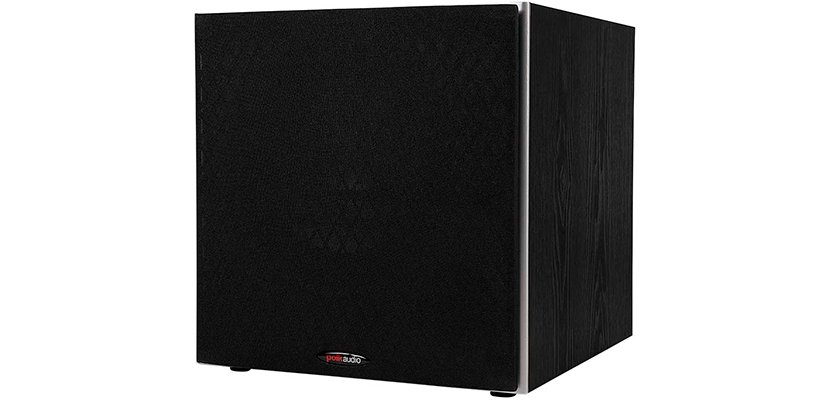
The 10-inch driver and sturdy build, wide frequency response with the regulated crossover settings, and quick pairing to various types of acoustic sets and devices are the features for the best home theater subwoofer under 300 dollars. The PSW10 model corresponds to all these requirements, while the absence of the LFE input might be a downside for surround sound enthusiasts.
It’s the active sub, which offers multiple connections including the RCA analog and stereo line-level inputs, and the speaker inputs and outputs (two pairs of spring terminals). This sub has the extended crossover that can be set from 80Hz to 160Hz so it will fit the entry-level speaker set and also get its place easily in the more high-end system.
The 10-inch driver is performed out of materials ensuring the rigidity and non-resonance during the quick motion. The driver is secured with the high-quality surrounding damping of the interference caused by the mechanical motion of the driver and electrical signals. It can handle the 100W power for peaks and 50W RMS providing a clean palpable bass with a solid base. This lets the sub get loud and immediately fill a middle-sized room with the beats. The unit works within the frequency range of 40Hz – 160Hz and emits the clear bass throughout the range.
The box is 14 inches wide, 14.38 inches high, and 16.13 inches deep. It weighs 26 pounds ensuring the stability of the box throughout the volume levels. This model has definitely all chances to become the best powered subwoofer under 300 dollars in your small-sized home theater.
Pros
- The voice coil and other elements are aligned with the laser technology to ensure the optimal frequency response.
- The elongated box configuration and four sturdy feet provide for additional stability of the sound without irrelevant thumps.
- Universal minimalist design and detachable grill make it fit in any environment.
Cons
- No direct input with crossover bypass.
- Volume control isn’t totally linear.
Video Polk Audio PSW10
Klipsch R-10SW
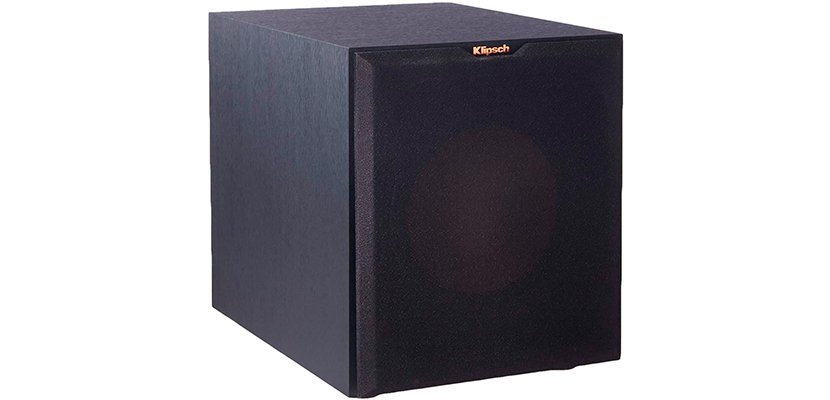
The high power capacity is the first thing noticeable when you turn on the R-10SW model. With 150W RMS power and 300W for the peak, it brings a concentrated deep bass with no muddiness at all throughout the frequency response (the latter makes 32hz – 120Hz). It will match both new acoustic sets and the older systems thanks to the line level and LFE inputs and will definitely challenge the competitors on your best home subwoofer under $300 list. It fits the movie watching and music listening purposes and is a good addition to any surround sound set.
Though the sub has a 10-inch driver and is quite compact, it can get very loud without side effects. The height of the R-10SW makes 14 inches, the depth is 15.7 inches, and the width is 12.5 inches. The all-digital amplifier combined with the sturdy build of the driver and casing provides a high sensitivity of 112 dB and lets keep the volume at the minimum rate (about 10% – 20%) for the TV watching and listening to the quiet music. Still, if you need to boost the sound to let your neighbors know you’ve got a sub, it can do it as well. The bass stays tight and doesn’t roll off or gains boominess with the volume increase.
The casing is made of the high-quality MDF and damps the vibration originating from the high driver’s excursion, efficiently. It weighs 25.5 pounds and stabilizes the sound well making a great option for the best subwoofer under $300.
Pros
- Accurate and musical sound reproduction.
- The automatic on/off function is supplemented with the front LED light showing the current status.
- The stiff copper-laden driver sounds and looks good.
Cons
- Requires a manual setup in many cases (not automatic receiver setup).
- The Gain control knob is a bit tight.
Video Klipsch R-10SW
Sony SACS9
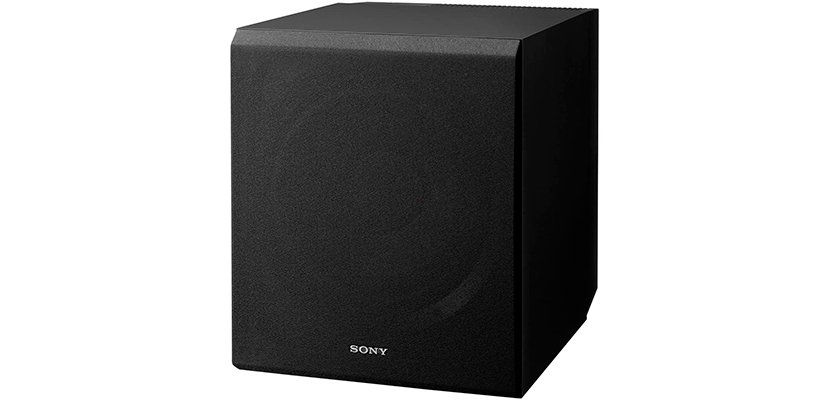
The SACS9 model from Sony has a close-to-low price but is equipped with the features of the more expensive competitors. It provides the sensitive controls and features a wide frequency range starting with 28Hz and reaching the 200Hz. This alone could let it opt for the title of the best subwoofer under $300. However, such a vast response is compensated with a relatively low 84 dB sensitivity. The speaker can get loud; still, the distortion becomes audible at about level 8 of the volume.
The sub is powered with the internal amplifier producing 115W of continuous power and 230W for peaks. This ensures good clarity throughout the low to middle volume levels and the low THD parameter (it goes below 10%). The speaker forms a concentrated punchy bass with a lot of dynamics. Still, it cannot be described as a “boomy” sound but rather as an “accurate” one. The frequencies in the range of 30Hz – 150Hz are transparent with the well audible middle line. This ensures the precise and musical bass making the speaker worth as the best subwoofer for music under 300 bucks. Still, the frequencies over 150Hz gain a fraction more of the distortion. The latter might pass unnoticed during the rock music listening and movie watching but becomes obvious once you turn on the more melodic tunes.
The sound is emitted via the 10-inch MRC cone, which ensures the durability of the sub and its constant sound quality. The wood veneer casing weighs 25.35 pounds and stabilizes the cone and the sound efficiently.
Pros
- Large crossover range (50Hz – 200Hz) makes the sub compatible with the various acoustic sets.
- A large ventilation grill secures the long-time operation.
- Compact box (11.61 x 15.74 x 13.58 inches) fits even the tight spaces.
Cons
- The automatic turn on / off function frequently works with the delay.
- The controls are thin plastic and feel flimsy.
Video Sony SACS9
BIC America F12
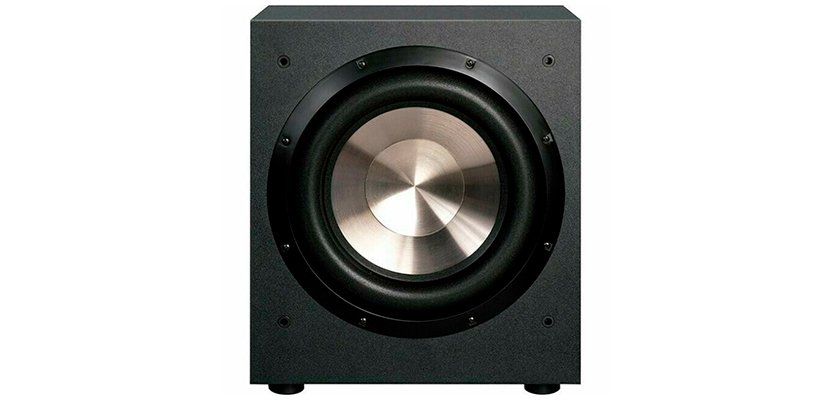
If you’re building your home theater system or decided to upgrade it while not breaking the bank, the F12 model might be the best $300 subwoofer for the purpose. It matches the multiple types of speaker sets, receivers and even offers the separate connectivity depending on the type of the sound format chosen. Besides, it’s quite a powerful sub with the 12-inch woofer.
The driver is made of the IMG and has a long throw design. It picks the frequencies within the 25Hz – 200Hz range and reproduces them faithfully, with the audible main line and details. The sub is equipped with the regulated crossover setting the speakers’ roll off within the 40Hz – 180Hz scale. The unit is backed up by the BASH amplifier producing the 475W peak power and 150W continuous one.
The connections on this sub include the two sets of speaker level ports (gold plated) intended for the receiver and the speakers. There’s also the RCA jack for hooking up to the receiver with 5.1-, 7.1- or 8.1-channel functionality. The back panel also features the phase switch and the on / off toggle selector with the integrated automatic functionality. The finishing touch to the picture of the best sub under 300 dollars is the speaker status LED light flashing red in the standby mode and green when the sub is working.
Pros
- The Venturi vent dampens the port noise ensuring the clean input signal.
- The toggle switch enables choosing between the Dolby Pro Logic and Dolby Digital or DTS formats depending on the playback.
- Precise and sensitive volume control knob with the marked volume levels.
Cons
- No dedicated sub output for the older receiver type (e.g. 2.1-channel receiver).
- Large (21 x 19 x 22 inches) and very heavy (42.7 pounds).
Video BIC America F12
Bic Acoustech PL-200 II
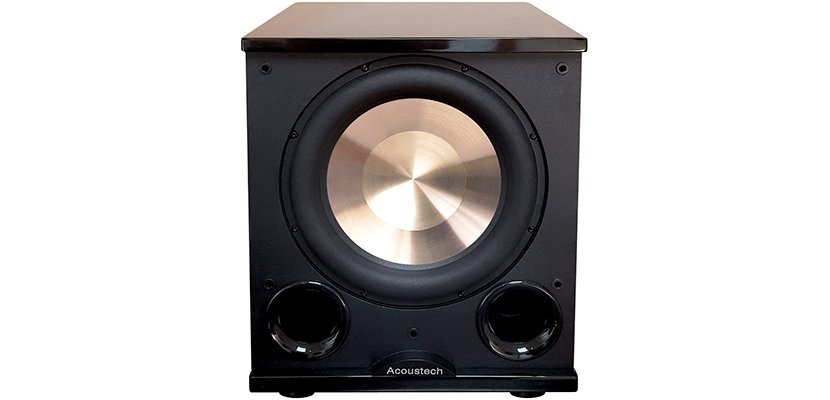
This powerful speaker has many features to fit almost any type of the surround sound system. The high sensitivity, long-excursion cone, the LED status light, and detachable cable let it claim its place as the best home subwoofer under 300 bucks in your home theater. Still, the sub makes the frequencies below 50Hz a bit blurry resulting in a more boomy sound. While this might be great for a backyard party, the audiophile might consider it a deal-breaker feature.
The subwoofer has a large frequency response scale starting with 22Hz and rolling off at 200Hz. The integrated crossover lets select the upper limit between 30Hz and 90Hz. The driver is 12-inch, with a long stiff cone made of polymer-injected material. The surrounding is a heavy-duty one damping the vibration efficiently. The speaker has the built-in amplifier of the BASH type powering the sub consistently. The latter has the 1,000W peak output and the 250W RMS one.
The sound of this sub is lively and punchy. It packs a lot of attack and clarity on the low-level frequencies. The sub-low ones are throbbing and palpable while the main line is optimally traced within the 50Hz-150Hz range.
The sub is tall having 17 ¼-inch height, and quite long (19 ½-inch depth, 14 ⅞-inch width). It’s also quite heavy weighing 46 pounds. Its lacquer finish and the colored cone make it well-noticeable in any room interior.
Pros
- Two front bass reflex ports enhance the surround effect creating a wide soundstage.
- The dedicated toggle switch lets choose between the sub’s crossover settings and the receiver’s ones.
- Unusual design with the differently colored and textured top part and removable lid on the back.
Cons
- The response is slow for music reproduction.
- The volume knob doesn’t have a digital indication.
Video Bic Acoustech PL-200 II
MTX Audio TNE212DV
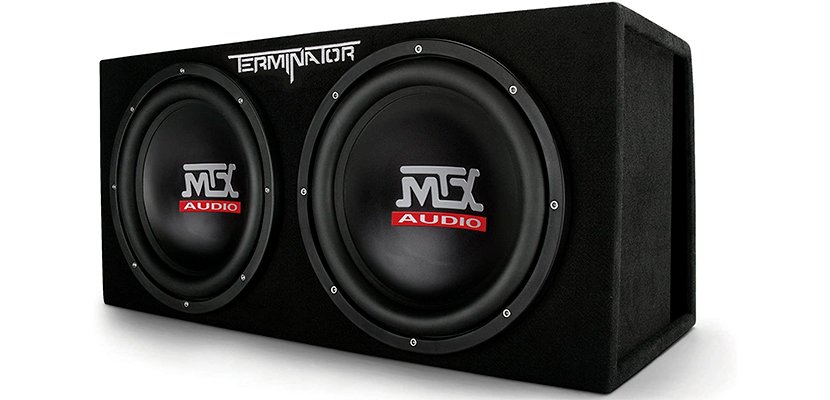
Getting two subs in a single enclosure is a great opportunity to save space and boost the sound in your car. But, is this sub good enough to be called the best car subwoofer under $300? The 12-inch drivers and high output together with the multiple ventilation technologies applied vote for it. Still, the wiring doesn’t feel durable and might require the replacement soon.
The total output of this speaker makes 2,000W for peaks, which makes 1,000W per each driver. The RMS parameter equals 500W per sub or 1,000W in total. The drivers are made of polypropylene and are quite stiff but lightweight. This results in the voluminous and thick bass with the palpable sub-low end. Still, the sensitivity isn’t the strong side of this speaker as it can bring more interference at 80 dB already. This difference is slight on hard rock and metal music but grows noticeable in the slow compositions playback.
The sub covers the range of frequencies from 20Hz to 200Hz. Each driver has a single voice coil with the 4-Ohm impedance wired to a joint terminal with the 2-Ohm impedance. This helps the car’s internal electric system manage the speaker without issues and lets the sub approach the position of the best car subwoofer under 300 dollars on the list.
The box is quite compact for a dual sub casing. It’s 14-inch tall, 29.5-inch wide, and 13.5-inch deep. It’s quite heavy at 52.9 pounds, but the weight also keeps the sub in place during the car tosses.
Pros
- The Spider Plateau venting system provides mechanical ventilation during the subwoofer work.
- Aircraft-grade casing upholstery.
- The frequency response is exact and hard throughout the range.
Cons
- No crossover settings.
- May influence the brightness of the car headlights on peaks.
Yamaha NS-SW050BL
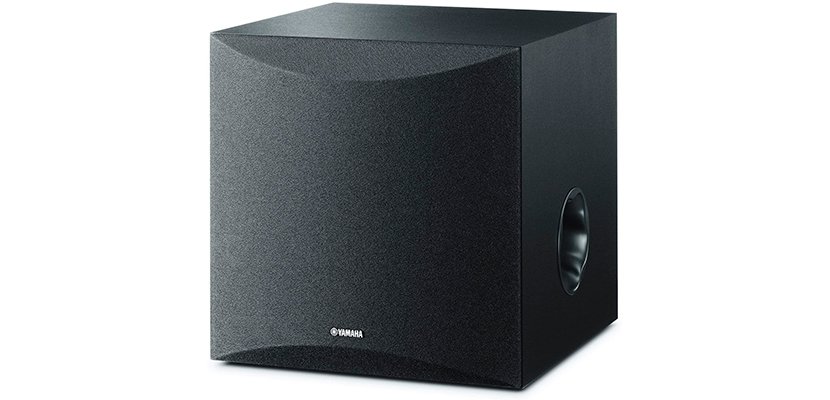
If the authenticity of the signal and solidity of build make your priority, this Yamaha speaker should definitely be on your best powered subwoofer under $300 comparison table. It’s simple in connection and setup, as well as in operation. Its compact size doesn’t just save space but also packs a whole number of technologies providing a clean and powerful bass.
The speaker is equipped with the 8-inch driver with the non-magnetic shield and enhanced with the Yamaha proprietary technology of Servo Amplifier II. The latter represents the efficient handling of the driver based on the negative impedance and constant current circuit and creating the “air woofer” effect. The latter amplifies the woofer’s output considerably making the 8-inch sub sound as confident and strong as some of its 10-inch competitors. The sub’s maximum output makes 100W while the RMS parameter is 50W.
Another peculiarity of this powered sub is the unusual shape of the bass reflex port, which is slightly twisted from the inside. In this way, Yamaha engineers tried to calm down the air turbulence and cut the external noise. This results in the richer and more true-to-source output, while some music lovers might find it to be a bit dry on the hard rock compositions.
The frequency range of this subwoofer makes 28Hz – 200Hz, which is quite wide. The response is even and smooth while the beats are precisely shaped and can hit hard. The box is compact with the 11 ½ -inch width and height, and 13 ⅜-inch depth. It weighs 18.7 pounds and is quite lightweight.
Pros
- Minimalist yet functional controls panel; sturdy switches and the volume knob.
- Accurate sound dynamics’ reproduction without delays or muddy ends.
- The rounded slanted front panel makes the design unique.
Cons
- No automatic shut off / turn on function.
- No speaker level connections.
Yamaha NS-SW100BL
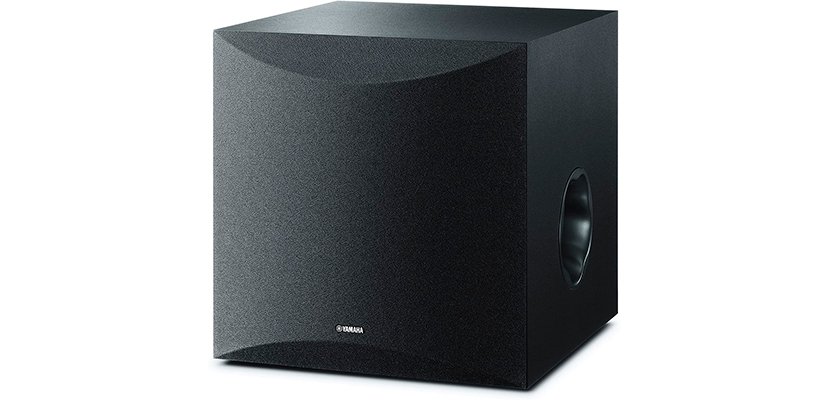
If you need the best $300 subwoofer for your middle-sized home theater, take a look at the NS-SW100BL sub from Yamaha. This speaker features the simplicity of connections and controls while packing quite a punch for the low-end of various music types and movie effects.
The sub includes the 10-inch woofer that features the rigid construction and is secured from the vibration and interference via the surround material and the specific circuit design. The circuit integrates the YST II block amplifying the signal efficiently and creating the effect of the larger driver performance. The side bass reflex port has a twisted shape to prevent the air turbulence and stabilize the airflow removing the hiss from the sound output.
The continuous power output for this model makes 50W and 100W for peaks. The sub has a smooth frequency response throughout the range of 25Hz – 180Hz. The bass is immersive and dynamic, with the well-drawn low and sub-low frequencies. The low-end is musical and diverse while the sub-low is thumpy.
The unit weighs 26.5 pounds and is 13 ⅞-inch tall, as much wide, and 16 ⅛-inch deep. It has a custom look thanks to the semicircle slanted top and bottom parts of the front grill. This model could well be the best sub under 300 dollars if only the connectivity wouldn’t consist only of the single RCA connection to the AV receiver / another device.
Pros
- Low THD factor (<10%) provides for the highly crisp sound within the frequency range.
- High sensitivity (100 dB) lets play the sub at a considerable volume without evident distortion.
- Comprehensive indications for the volume knob and the power button.
Cons
- Crossover regulation isn’t supported.
- The power cord isn’t detachable.
Video Yamaha NS-SW100BL
Amazon Echo Sub
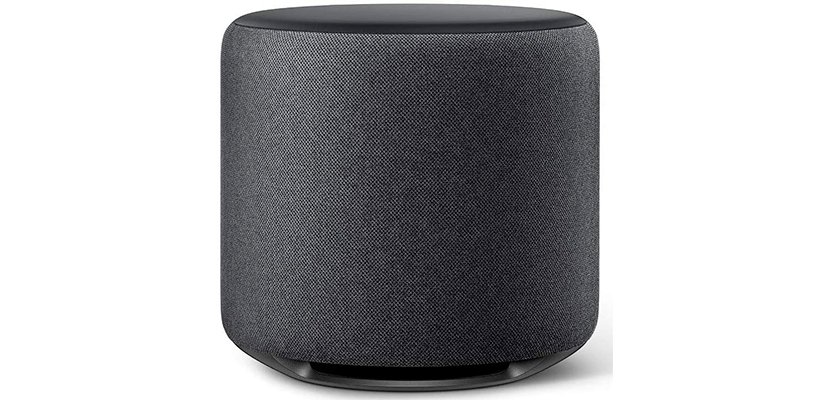
If you have or plan to have the Echo Dot set or any other Echo device, this sub is a must-have. It takes little space, connects wirelessly, and improves the low end of the regular two-speaker set. Considering the high quality of the bass reproduction, it could be called the best subwoofer for music under 300 dollars. Still, its functionality is limited by Echo products only, though it does pair with the Fire TV as well.
The speaker is performed in the cylindrical shape and is 8.3 inches tall and 8 inches wide. It’s also lightweight weighing just 9.3 pounds. Though the sub can be put on the floor or a shelf, it’s better to have a soft surface underneath. Otherwise, the down-firing construction of the woofer might result in too much resonance and boost the boominess and harshness.
The 6-inch woofer works within the frequency response range (30Hz – 200Hz) and has the maximum output at 100W (50W RMS). The crossover settings make 50Hz – 200Hz and work flawlessly with the Echo speakers. The bass rolls off slightly at 30Hz but otherwise, is well audible even at the low volume levels. The base is confident, and the bass flows steadily, though the main line might be lost in certain episodes when watching the movie with the surround sound coding.
The sub supports and connects through the dual-band Wi-Fi to hook up to other system components and the managing app / music source.
Pros
- Can pair and become the part of the multi-room speaker setup.
- Fully compatible with the Alexa app to be managed via voice commands.
- Granted Amazon support and warranty.
Cons
- No bass reflex port results in the narrow soundstage.
- The initial setup is cumbersome, problems arise with the recognition of the sub / setting the volume and crossover settings.
Video Amazon Echo Sub
Polk Audio PSW505
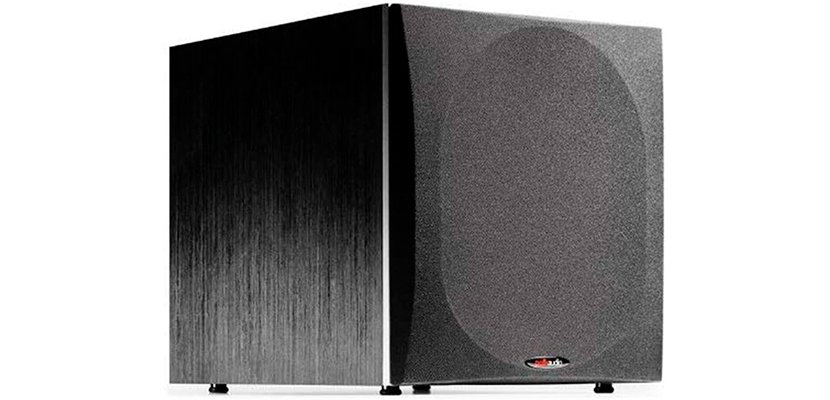
Having an accurate frequency response, good dynamics, and the powerful built-in amp, this subwoofer produces a tight precise low-end with a lot of dynamics. It fits movie watching, music listening, and gaming purposes and might be the best home theater subwoofer under $300. While its frequency response isn’t as wide as in many competitors, the power of the output is strong and the sound fills the middle-sized and even large room immediately.
The PSW505 features a 12-inch woofer that has a prolonged cone thanks to the high-roll foam surround material, which budges out the box. The driver is made by the patented Dynamic balance technology cutting the noise provoked by the driver’s movement and producing the clean bass sound. The peak output reaches 460W while the average capacity makes 300W.
The sub catches the low frequencies within the range of 23Hz – 125Hz and reproduces them faithfully, without abrupt roll-offs or cuts. The crossover lets regulate the sub getting active within the 60Hz – 125Hz scale, and works precisely. The response is solid all the way through, with the well-heard main line and the palpable thump.
The connections panel is versatile ensuring the compatibility with any system and AV device. There are RCA Line in and LFE inputs, the speaker level ins and outs. Controls include the volume knob, crossover dial, toggle switches for power modes, and phase shifting. The sub has the standard dimension of 18.19-inch height, 15.13-inch width, and 18.28-inch depth, and weighs 48 pounds.
Pros
- The vent is large and slotted for efficient cooling.
- A separate AC power switch lets completely disconnect the sub without unplugging it.
- Real wood veneer used for the finish material; dampens the vibration efficiently.
Cons
- The cubical shape and the heavy weight limit the area of the sub’s placement.
- The capacitors integrated aren’t sturdy.
Video Polk Audio PSW505
Buyer’s Guide
What Features You Can Get Buying the Subwoofers Under $300?
More solid build. In comparison with cheaper subs, the subwoofers under $300 offer the thicker casing, more rigid woofer cones, and are often equipped with the discrete amplification circuit to avoid the internal noise. These subs aren’t made of the wood or another solid material like some of the high-end models.
Still, they’re sturdy enough to dampen the vibration and interference caused by the high-excursion drivers.
Different sizes of drivers. The subs in a certain price category might vary from the small 6-inch to 12-inch woofer ones. The larger driver moves more air and usually provides the richer bass. However, the driver material matters as well. The paper cones sound good but tend to wear out over time. The alternatives make Mica cellular, IMG, and other materials.
Versatile connectivity. While a single type of input (e.g. the RCA sub out or the speaker level terminal) can be present in any price range, the majority of subs under $300 offer at least two options. Some include the LFE input as well
Active / passive type. The active subs integrate the amp and are quicker to set up. Still, the passive subwoofers bring more options to upgrade the sound or get the particular depth, strength, and accuracy of bass.
Automatic turn on / off. This function is often present in the under $300 subwoofers. It lets the speaker get activated when the connected receiver is turned on and goes to sleep with it. In most subs, this function can also be inactivated.
Phase control. As many subwoofers below $300 are intended for a wide usage including the surround sound systems, they offer the phase switch to choose the optimal sounding pattern.
Crossover settings. You can select the frequency at which the sub will take over the reproduction of the low-end from other speakers. In many units under $300, the crossover settings are variable and have a wide range.
Volume control on the active models.
Box size and shape. The modern subs have various shapes and dimensions. The weight also differs but doesn’t usually get below 8 pounds.
How to Set Up the Subwoofer?
The setup of a sub depends on the number of features and connection ports it has. The more they are, the more options you have to connect to the various speaker systems / receivers and to regulate the sub output.
If the subwoofer has the RCA input, insert the cable and plug the opposite jack into the subwoofer output of your receiver. If your receiver supports the LFE connection, the latter usually provides more versatility and control over sub’s sound. Besides, you can connect a subwoofer directly to the speakers via the speaker level ports.
If the power cord is wired, all you have to do is plug it into the outlet. If it’s detachable, insert it into the port and then plug in.
If your sub has a volume dial, following the manufacturer recommendations would be the optimal way of setting up the subwoofer. Some recommend winding the volume up while many advise to keep it at a low position. If there’s no manufacturer advice, set the volume to half of the range. Upon that, you can change the gain to make the output fit your personal taste.
The crossover settings can be selected via the dedicated switch on the subwoofer or via the AV receiver’s menu. Many subs offer a wide range of points at which the signal would be handled by the sub only. The optimal setting depends on your sub output. If the latter is accurate and musical, you might set it at the highest frequency available (e.g. 150Hz or 200Hz). If the sub’s sweet spot is within the lower frequencies, it’s worth selecting 80Hz or 60Hz as the limit for the crossover bypass.
In some subwoofer models, there might be a dedicated selector to choose the optimal performance with regard to the format of sound coding (e.g. Dolby Digital or Surround).
The automatic turn on / off function is quite useful and helps avoid switching on and off the sub manually each time when you play on using it. However, not all subwoofers pair to the AV receivers seamlessly so that the sub might get activated or go to sleep with the delay or not do it at all. To prevent the circuitry from circulating in the sub, make sure to switch it off if it doesn’t turn off by itself.

Hi everyone! I’m Thomas Moody, also known as Guitarzan.
